IBU5HRM Human Resource Management Case Study Report
VerifiedAdded on 2023/01/13
|12
|3195
|43
Report
AI Summary
This report analyzes Human Resource Management (HRM) principles using a case study of 'No Name Aircraft'. It explores organizational culture, identifying issues like poor communication and negative work environments. The report delves into diversity management, highlighting the company's shortcomings in fostering an inclusive workplace and the impact of biased practices. Furthermore, it examines international performance management, revealing challenges in evaluation processes and a lack of synchronization between subsidiaries. The report also addresses training and development, noting the absence of a human element in online training resources and the lack of career development plans. The conclusion provides recommendations for restructuring HRM policies, including implementing career extension policies, mentorship programs, and inclusive diversity management practices to address the identified challenges and improve the overall effectiveness of the organization.
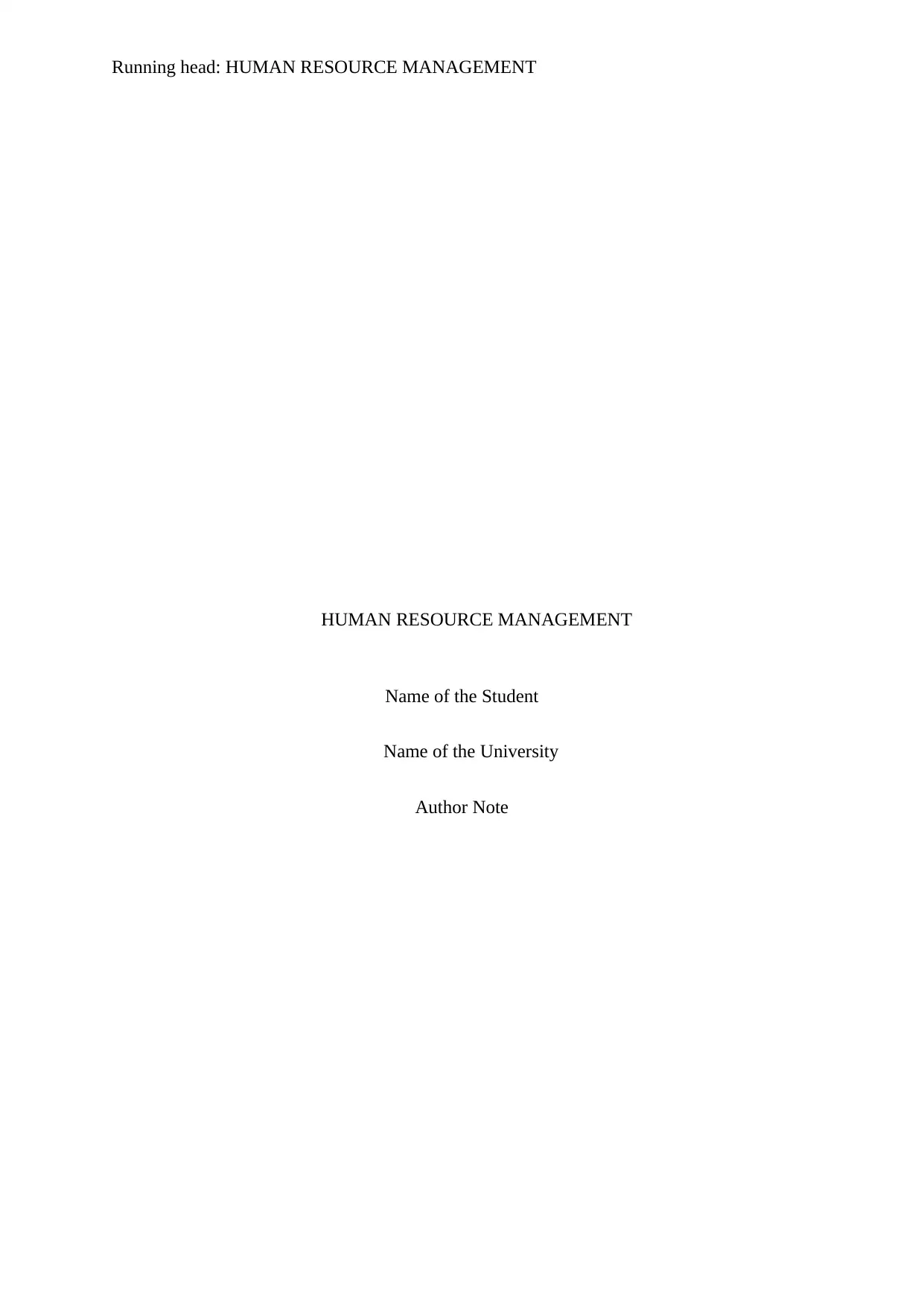
Running head: HUMAN RESOURCE MANAGEMENT
HUMAN RESOURCE MANAGEMENT
Name of the Student
Name of the University
Author Note
HUMAN RESOURCE MANAGEMENT
Name of the Student
Name of the University
Author Note
Paraphrase This Document
Need a fresh take? Get an instant paraphrase of this document with our AI Paraphraser

1HUMAN RESOURCE MANAGEMENT
The tactical approach application for the effective management of human element of
organization is known as Human Resource Management. The Human Resource Management
aims at improving work culture by implementing policies and regulations. The structure of
management is designed for the purpose of maximizing performance of employees in regards
with the employer’s aims and objective (Boselie 2016). The organizational strategies, which
aims at promoting inclusive policies of employees from various cultural backgrounds in an
organizational setting. Culture can be defined as the behaviours and values, which contributes
towards unique psychological and social environment of organization (Anitha 2016). The
process of project management, which enables evaluation and improvement of individual as
well as corporate performance regarding goals and objectives of the organization, is known as
International performance management. International management is applicable for
Multinational companies or a company, which is operating on a global scale. Training and
Development is comprised of the skills and competencies for improving effectiveness and
efficiency of organizations as well as the improvement of individual employees. Training is
the immediate change in regards with organizational changes but development is a
progressive process. The purpose of the paper is to summarize the different concepts of
Human Resource Management by an example of a case study of ‘No name aircraft’. The
paper will highlight the concept of Diversity Management and Culture and International
Performance Management, Training and Development. Presenting the deduced idea of the
case study will conclude the paper.
Culture
The underlying value, belief, manner of interaction and assumptions, which
contributes towards the unique psychological and social environment of a specific
organization, is known as Organizational Culture. It is comprised of organization’s
experiences, expectations, values and philosophy, which directs the behaviour of the
employees. The organizational culture is reflected through image of employees, working
The tactical approach application for the effective management of human element of
organization is known as Human Resource Management. The Human Resource Management
aims at improving work culture by implementing policies and regulations. The structure of
management is designed for the purpose of maximizing performance of employees in regards
with the employer’s aims and objective (Boselie 2016). The organizational strategies, which
aims at promoting inclusive policies of employees from various cultural backgrounds in an
organizational setting. Culture can be defined as the behaviours and values, which contributes
towards unique psychological and social environment of organization (Anitha 2016). The
process of project management, which enables evaluation and improvement of individual as
well as corporate performance regarding goals and objectives of the organization, is known as
International performance management. International management is applicable for
Multinational companies or a company, which is operating on a global scale. Training and
Development is comprised of the skills and competencies for improving effectiveness and
efficiency of organizations as well as the improvement of individual employees. Training is
the immediate change in regards with organizational changes but development is a
progressive process. The purpose of the paper is to summarize the different concepts of
Human Resource Management by an example of a case study of ‘No name aircraft’. The
paper will highlight the concept of Diversity Management and Culture and International
Performance Management, Training and Development. Presenting the deduced idea of the
case study will conclude the paper.
Culture
The underlying value, belief, manner of interaction and assumptions, which
contributes towards the unique psychological and social environment of a specific
organization, is known as Organizational Culture. It is comprised of organization’s
experiences, expectations, values and philosophy, which directs the behaviour of the
employees. The organizational culture is reflected through image of employees, working
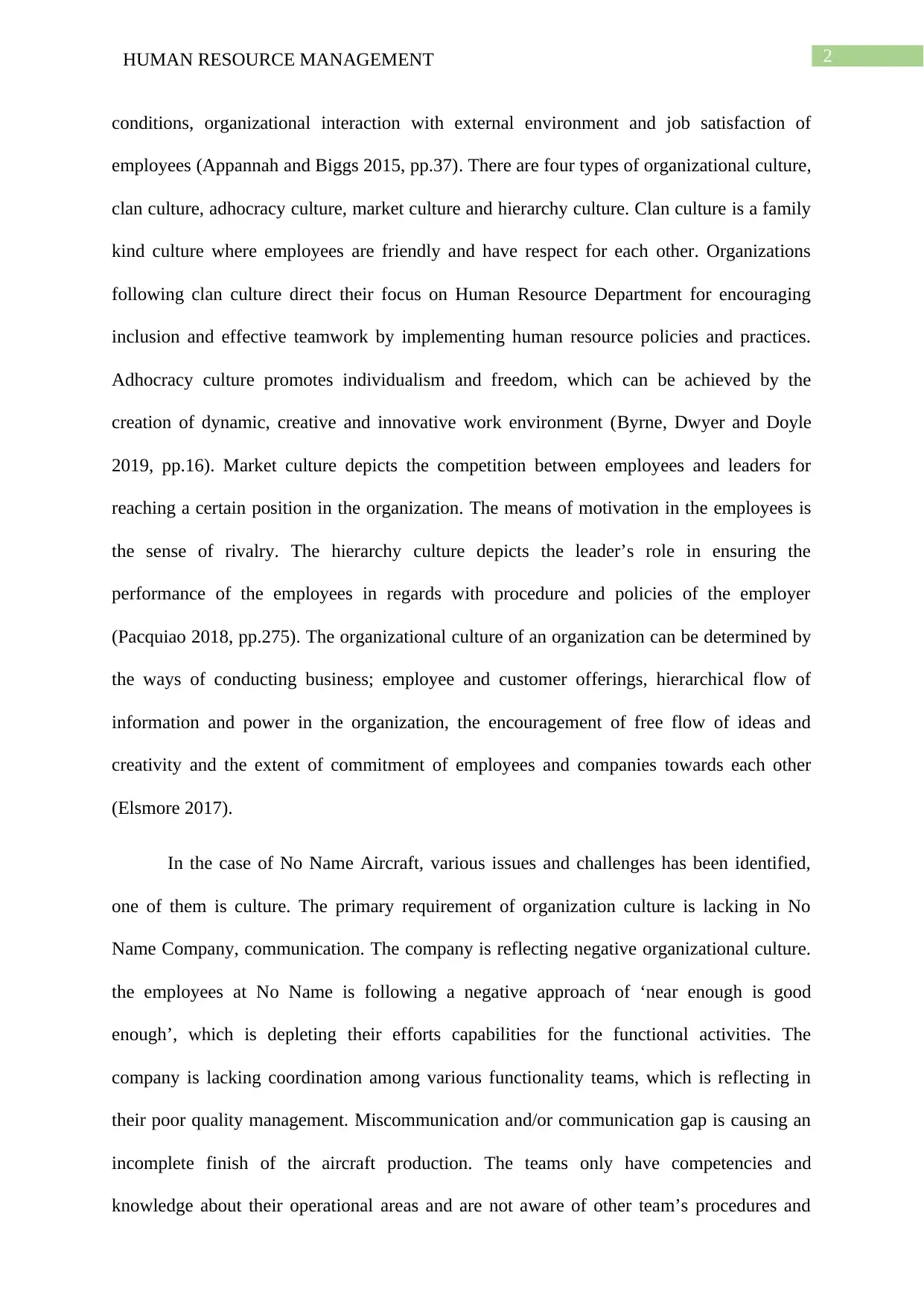
2HUMAN RESOURCE MANAGEMENT
conditions, organizational interaction with external environment and job satisfaction of
employees (Appannah and Biggs 2015, pp.37). There are four types of organizational culture,
clan culture, adhocracy culture, market culture and hierarchy culture. Clan culture is a family
kind culture where employees are friendly and have respect for each other. Organizations
following clan culture direct their focus on Human Resource Department for encouraging
inclusion and effective teamwork by implementing human resource policies and practices.
Adhocracy culture promotes individualism and freedom, which can be achieved by the
creation of dynamic, creative and innovative work environment (Byrne, Dwyer and Doyle
2019, pp.16). Market culture depicts the competition between employees and leaders for
reaching a certain position in the organization. The means of motivation in the employees is
the sense of rivalry. The hierarchy culture depicts the leader’s role in ensuring the
performance of the employees in regards with procedure and policies of the employer
(Pacquiao 2018, pp.275). The organizational culture of an organization can be determined by
the ways of conducting business; employee and customer offerings, hierarchical flow of
information and power in the organization, the encouragement of free flow of ideas and
creativity and the extent of commitment of employees and companies towards each other
(Elsmore 2017).
In the case of No Name Aircraft, various issues and challenges has been identified,
one of them is culture. The primary requirement of organization culture is lacking in No
Name Company, communication. The company is reflecting negative organizational culture.
the employees at No Name is following a negative approach of ‘near enough is good
enough’, which is depleting their efforts capabilities for the functional activities. The
company is lacking coordination among various functionality teams, which is reflecting in
their poor quality management. Miscommunication and/or communication gap is causing an
incomplete finish of the aircraft production. The teams only have competencies and
knowledge about their operational areas and are not aware of other team’s procedures and
conditions, organizational interaction with external environment and job satisfaction of
employees (Appannah and Biggs 2015, pp.37). There are four types of organizational culture,
clan culture, adhocracy culture, market culture and hierarchy culture. Clan culture is a family
kind culture where employees are friendly and have respect for each other. Organizations
following clan culture direct their focus on Human Resource Department for encouraging
inclusion and effective teamwork by implementing human resource policies and practices.
Adhocracy culture promotes individualism and freedom, which can be achieved by the
creation of dynamic, creative and innovative work environment (Byrne, Dwyer and Doyle
2019, pp.16). Market culture depicts the competition between employees and leaders for
reaching a certain position in the organization. The means of motivation in the employees is
the sense of rivalry. The hierarchy culture depicts the leader’s role in ensuring the
performance of the employees in regards with procedure and policies of the employer
(Pacquiao 2018, pp.275). The organizational culture of an organization can be determined by
the ways of conducting business; employee and customer offerings, hierarchical flow of
information and power in the organization, the encouragement of free flow of ideas and
creativity and the extent of commitment of employees and companies towards each other
(Elsmore 2017).
In the case of No Name Aircraft, various issues and challenges has been identified,
one of them is culture. The primary requirement of organization culture is lacking in No
Name Company, communication. The company is reflecting negative organizational culture.
the employees at No Name is following a negative approach of ‘near enough is good
enough’, which is depleting their efforts capabilities for the functional activities. The
company is lacking coordination among various functionality teams, which is reflecting in
their poor quality management. Miscommunication and/or communication gap is causing an
incomplete finish of the aircraft production. The teams only have competencies and
knowledge about their operational areas and are not aware of other team’s procedures and
⊘ This is a preview!⊘
Do you want full access?
Subscribe today to unlock all pages.

Trusted by 1+ million students worldwide

3HUMAN RESOURCE MANAGEMENT
policies, which result in the mismanagement of functions of production. The justification of
the incompetency and miscommunication of the teams can be directed towards the
communication gap between the hierarchical structures of the company. The reasons for the
poor quality management can also be the negligence of line managers for carrying out
effective communication network with the associated subsidiaries.
Diversity Management
The practices and activities of supporting and addressing various personal, cultural
and lifestyle characteristics in a confined organizational group are known as Diversity
management (Mor Barak 2015, pp.83). The activities of management include making the
group aware of the diversified culture and beliefs as well as reflecting support and respect for
the differences. Diversity Management is considered as the key growth for the competitive
business marketplace as diversity in organization allows collaborating ideas, competencies
and skills towards a common goal (Garg, Pandey and Vashishta 2017, pp.41). The
importance of diversity management can be reflected through various areas. One of them
being innovation, incorporating diverse workforce in the cultural setup will allow the flow of
creative ideas and views (Ashikali and Groeneveld 2015, pp.757). Diversified workforce also
allows organizations to attract skilled labour and customers. Diversity management helps in
opening global opportunities for organizations as the offerings can be enhanced with the
presence of a diverse organizational background. Diversity management instils cultural
intelligence in an organization (Ashikali and Groeneveld 2015, pp.146).
From the case, poor diversity management practices can be identified. The company
is experiencing challenges in understanding the importance of a diverse culture. Headquarter
portrays intolerance for working among a diverse working population. The improper working
relationship of the company can be reflected from the intolerance of the senior employees for
working with the trainees of No Name Aircraft. Moreover the subsidies of the aircraft
policies, which result in the mismanagement of functions of production. The justification of
the incompetency and miscommunication of the teams can be directed towards the
communication gap between the hierarchical structures of the company. The reasons for the
poor quality management can also be the negligence of line managers for carrying out
effective communication network with the associated subsidiaries.
Diversity Management
The practices and activities of supporting and addressing various personal, cultural
and lifestyle characteristics in a confined organizational group are known as Diversity
management (Mor Barak 2015, pp.83). The activities of management include making the
group aware of the diversified culture and beliefs as well as reflecting support and respect for
the differences. Diversity Management is considered as the key growth for the competitive
business marketplace as diversity in organization allows collaborating ideas, competencies
and skills towards a common goal (Garg, Pandey and Vashishta 2017, pp.41). The
importance of diversity management can be reflected through various areas. One of them
being innovation, incorporating diverse workforce in the cultural setup will allow the flow of
creative ideas and views (Ashikali and Groeneveld 2015, pp.757). Diversified workforce also
allows organizations to attract skilled labour and customers. Diversity management helps in
opening global opportunities for organizations as the offerings can be enhanced with the
presence of a diverse organizational background. Diversity management instils cultural
intelligence in an organization (Ashikali and Groeneveld 2015, pp.146).
From the case, poor diversity management practices can be identified. The company
is experiencing challenges in understanding the importance of a diverse culture. Headquarter
portrays intolerance for working among a diverse working population. The improper working
relationship of the company can be reflected from the intolerance of the senior employees for
working with the trainees of No Name Aircraft. Moreover the subsidies of the aircraft
Paraphrase This Document
Need a fresh take? Get an instant paraphrase of this document with our AI Paraphraser

4HUMAN RESOURCE MANAGEMENT
company discourage or are not involved in the recruitment practice of disabled people. The
biasness and improper diversity management is caused by the poor management policies. The
lack of clear set of objectives of policies and practices causes the means of discrimination and
biasness. The Human Resource Management does not focus on developing the understanding
of workforce conflict and miscommunication (Ashikali and Groeneveld 2015, pp.757).
Policies and practices have to be framed for growing understanding and respect among
employees. For developing the sense of harmony in the workplace and to build new
opportunities for organizations, diversity management gave to be practiced.
International Performance Management
The ability of Multinational organizations in evaluating performances of individuals,
corporate and subsidiary performance of an organization is known as International
Performance Management. The evaluation is facilitated on the grounds of pre-set aims and
objectives (Kampkötter 2017, pp.750). The performance can be affected by factors like host
environment, headquarter support, compensation package as well as the cultural adjustments.
Internal Performance Management is directly linked with the performance appraisal policies
of organization (Ikramullah et al. 2016, pp.334). Management of employee performances on
the basis of strategic needs, customer preferences and organizational objectives in the key
role of International human resource management. International Performance Management
helps in setting goals and objectives by enabling employees to develop a clear understanding
of the target as well as it allows the employer to identify the existence of challenges or gap in
the organizational system. It allows the employer to plan for coaching or mentoring needs for
specific functionalities. After the identification of gaps and mentoring needs, development
planning is carried out for improving the skills and competencies of the organizational assets.
The most important step for International Performance Management is rewarding and
recognizing the performance or skill development of employees. The assessment can
determine the behavioural change and cultural changes in organizations.
company discourage or are not involved in the recruitment practice of disabled people. The
biasness and improper diversity management is caused by the poor management policies. The
lack of clear set of objectives of policies and practices causes the means of discrimination and
biasness. The Human Resource Management does not focus on developing the understanding
of workforce conflict and miscommunication (Ashikali and Groeneveld 2015, pp.757).
Policies and practices have to be framed for growing understanding and respect among
employees. For developing the sense of harmony in the workplace and to build new
opportunities for organizations, diversity management gave to be practiced.
International Performance Management
The ability of Multinational organizations in evaluating performances of individuals,
corporate and subsidiary performance of an organization is known as International
Performance Management. The evaluation is facilitated on the grounds of pre-set aims and
objectives (Kampkötter 2017, pp.750). The performance can be affected by factors like host
environment, headquarter support, compensation package as well as the cultural adjustments.
Internal Performance Management is directly linked with the performance appraisal policies
of organization (Ikramullah et al. 2016, pp.334). Management of employee performances on
the basis of strategic needs, customer preferences and organizational objectives in the key
role of International human resource management. International Performance Management
helps in setting goals and objectives by enabling employees to develop a clear understanding
of the target as well as it allows the employer to identify the existence of challenges or gap in
the organizational system. It allows the employer to plan for coaching or mentoring needs for
specific functionalities. After the identification of gaps and mentoring needs, development
planning is carried out for improving the skills and competencies of the organizational assets.
The most important step for International Performance Management is rewarding and
recognizing the performance or skill development of employees. The assessment can
determine the behavioural change and cultural changes in organizations.
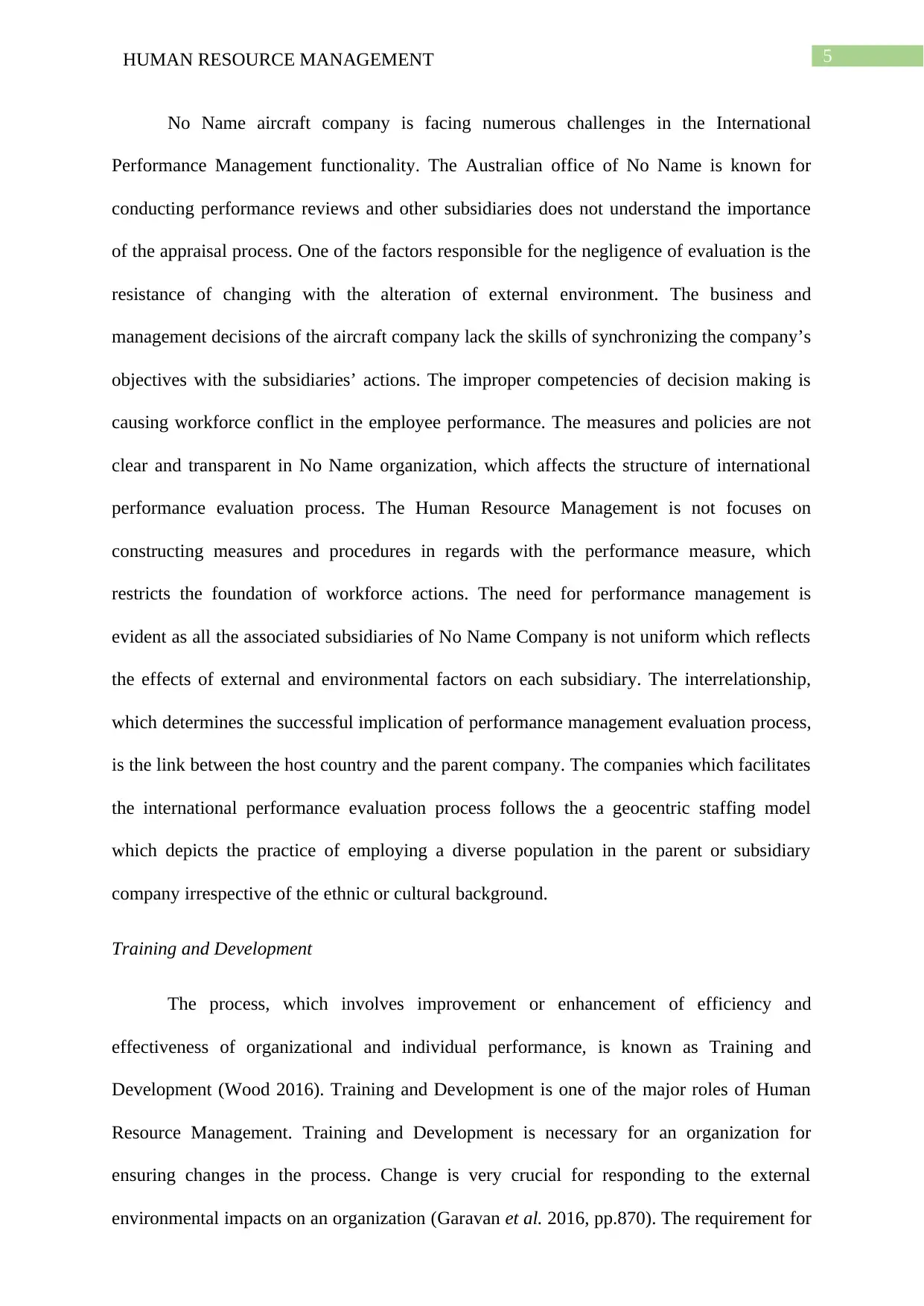
5HUMAN RESOURCE MANAGEMENT
No Name aircraft company is facing numerous challenges in the International
Performance Management functionality. The Australian office of No Name is known for
conducting performance reviews and other subsidiaries does not understand the importance
of the appraisal process. One of the factors responsible for the negligence of evaluation is the
resistance of changing with the alteration of external environment. The business and
management decisions of the aircraft company lack the skills of synchronizing the company’s
objectives with the subsidiaries’ actions. The improper competencies of decision making is
causing workforce conflict in the employee performance. The measures and policies are not
clear and transparent in No Name organization, which affects the structure of international
performance evaluation process. The Human Resource Management is not focuses on
constructing measures and procedures in regards with the performance measure, which
restricts the foundation of workforce actions. The need for performance management is
evident as all the associated subsidiaries of No Name Company is not uniform which reflects
the effects of external and environmental factors on each subsidiary. The interrelationship,
which determines the successful implication of performance management evaluation process,
is the link between the host country and the parent company. The companies which facilitates
the international performance evaluation process follows the a geocentric staffing model
which depicts the practice of employing a diverse population in the parent or subsidiary
company irrespective of the ethnic or cultural background.
Training and Development
The process, which involves improvement or enhancement of efficiency and
effectiveness of organizational and individual performance, is known as Training and
Development (Wood 2016). Training and Development is one of the major roles of Human
Resource Management. Training and Development is necessary for an organization for
ensuring changes in the process. Change is very crucial for responding to the external
environmental impacts on an organization (Garavan et al. 2016, pp.870). The requirement for
No Name aircraft company is facing numerous challenges in the International
Performance Management functionality. The Australian office of No Name is known for
conducting performance reviews and other subsidiaries does not understand the importance
of the appraisal process. One of the factors responsible for the negligence of evaluation is the
resistance of changing with the alteration of external environment. The business and
management decisions of the aircraft company lack the skills of synchronizing the company’s
objectives with the subsidiaries’ actions. The improper competencies of decision making is
causing workforce conflict in the employee performance. The measures and policies are not
clear and transparent in No Name organization, which affects the structure of international
performance evaluation process. The Human Resource Management is not focuses on
constructing measures and procedures in regards with the performance measure, which
restricts the foundation of workforce actions. The need for performance management is
evident as all the associated subsidiaries of No Name Company is not uniform which reflects
the effects of external and environmental factors on each subsidiary. The interrelationship,
which determines the successful implication of performance management evaluation process,
is the link between the host country and the parent company. The companies which facilitates
the international performance evaluation process follows the a geocentric staffing model
which depicts the practice of employing a diverse population in the parent or subsidiary
company irrespective of the ethnic or cultural background.
Training and Development
The process, which involves improvement or enhancement of efficiency and
effectiveness of organizational and individual performance, is known as Training and
Development (Wood 2016). Training and Development is one of the major roles of Human
Resource Management. Training and Development is necessary for an organization for
ensuring changes in the process. Change is very crucial for responding to the external
environmental impacts on an organization (Garavan et al. 2016, pp.870). The requirement for
⊘ This is a preview!⊘
Do you want full access?
Subscribe today to unlock all pages.

Trusted by 1+ million students worldwide
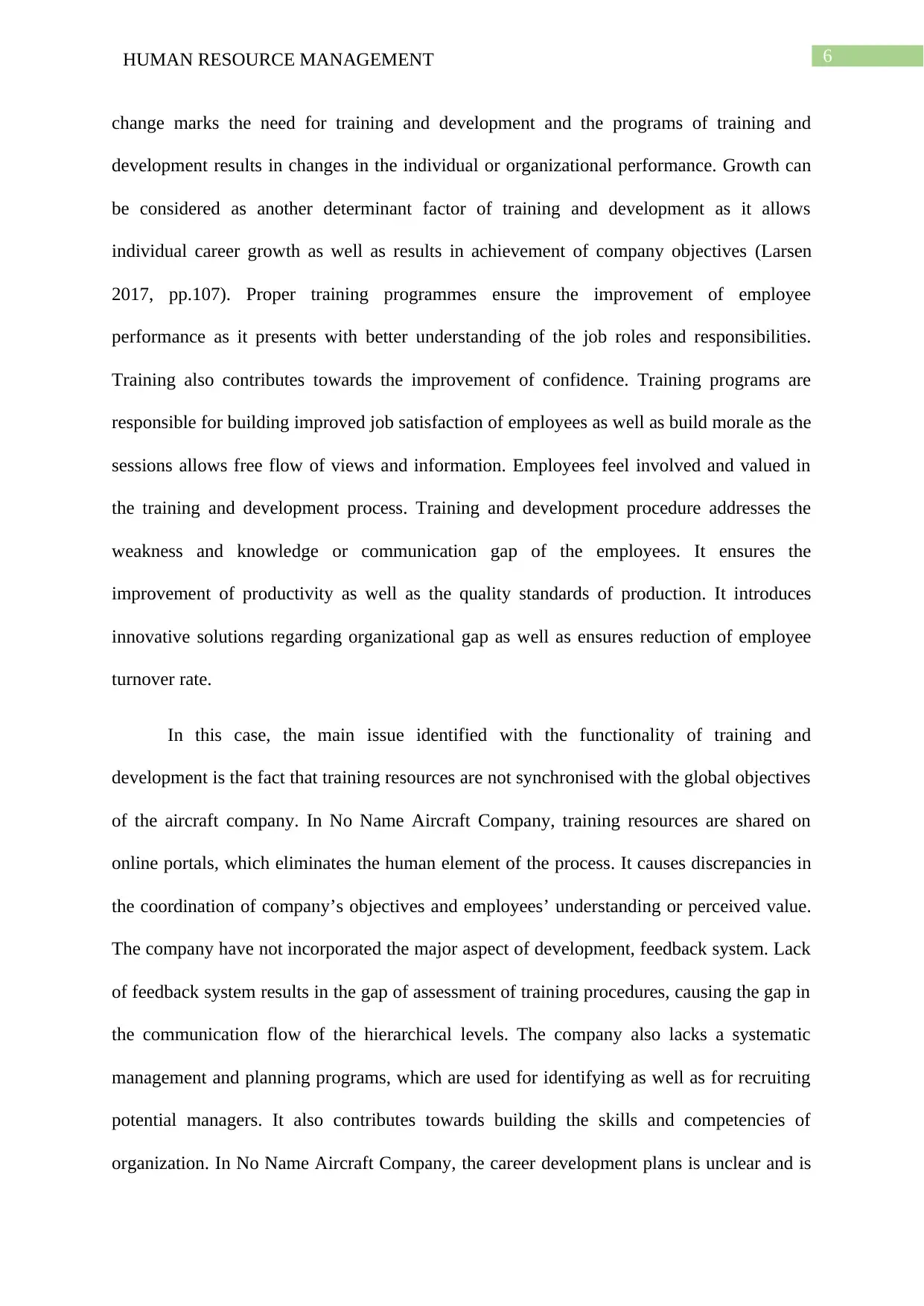
6HUMAN RESOURCE MANAGEMENT
change marks the need for training and development and the programs of training and
development results in changes in the individual or organizational performance. Growth can
be considered as another determinant factor of training and development as it allows
individual career growth as well as results in achievement of company objectives (Larsen
2017, pp.107). Proper training programmes ensure the improvement of employee
performance as it presents with better understanding of the job roles and responsibilities.
Training also contributes towards the improvement of confidence. Training programs are
responsible for building improved job satisfaction of employees as well as build morale as the
sessions allows free flow of views and information. Employees feel involved and valued in
the training and development process. Training and development procedure addresses the
weakness and knowledge or communication gap of the employees. It ensures the
improvement of productivity as well as the quality standards of production. It introduces
innovative solutions regarding organizational gap as well as ensures reduction of employee
turnover rate.
In this case, the main issue identified with the functionality of training and
development is the fact that training resources are not synchronised with the global objectives
of the aircraft company. In No Name Aircraft Company, training resources are shared on
online portals, which eliminates the human element of the process. It causes discrepancies in
the coordination of company’s objectives and employees’ understanding or perceived value.
The company have not incorporated the major aspect of development, feedback system. Lack
of feedback system results in the gap of assessment of training procedures, causing the gap in
the communication flow of the hierarchical levels. The company also lacks a systematic
management and planning programs, which are used for identifying as well as for recruiting
potential managers. It also contributes towards building the skills and competencies of
organization. In No Name Aircraft Company, the career development plans is unclear and is
change marks the need for training and development and the programs of training and
development results in changes in the individual or organizational performance. Growth can
be considered as another determinant factor of training and development as it allows
individual career growth as well as results in achievement of company objectives (Larsen
2017, pp.107). Proper training programmes ensure the improvement of employee
performance as it presents with better understanding of the job roles and responsibilities.
Training also contributes towards the improvement of confidence. Training programs are
responsible for building improved job satisfaction of employees as well as build morale as the
sessions allows free flow of views and information. Employees feel involved and valued in
the training and development process. Training and development procedure addresses the
weakness and knowledge or communication gap of the employees. It ensures the
improvement of productivity as well as the quality standards of production. It introduces
innovative solutions regarding organizational gap as well as ensures reduction of employee
turnover rate.
In this case, the main issue identified with the functionality of training and
development is the fact that training resources are not synchronised with the global objectives
of the aircraft company. In No Name Aircraft Company, training resources are shared on
online portals, which eliminates the human element of the process. It causes discrepancies in
the coordination of company’s objectives and employees’ understanding or perceived value.
The company have not incorporated the major aspect of development, feedback system. Lack
of feedback system results in the gap of assessment of training procedures, causing the gap in
the communication flow of the hierarchical levels. The company also lacks a systematic
management and planning programs, which are used for identifying as well as for recruiting
potential managers. It also contributes towards building the skills and competencies of
organization. In No Name Aircraft Company, the career development plans is unclear and is
Paraphrase This Document
Need a fresh take? Get an instant paraphrase of this document with our AI Paraphraser
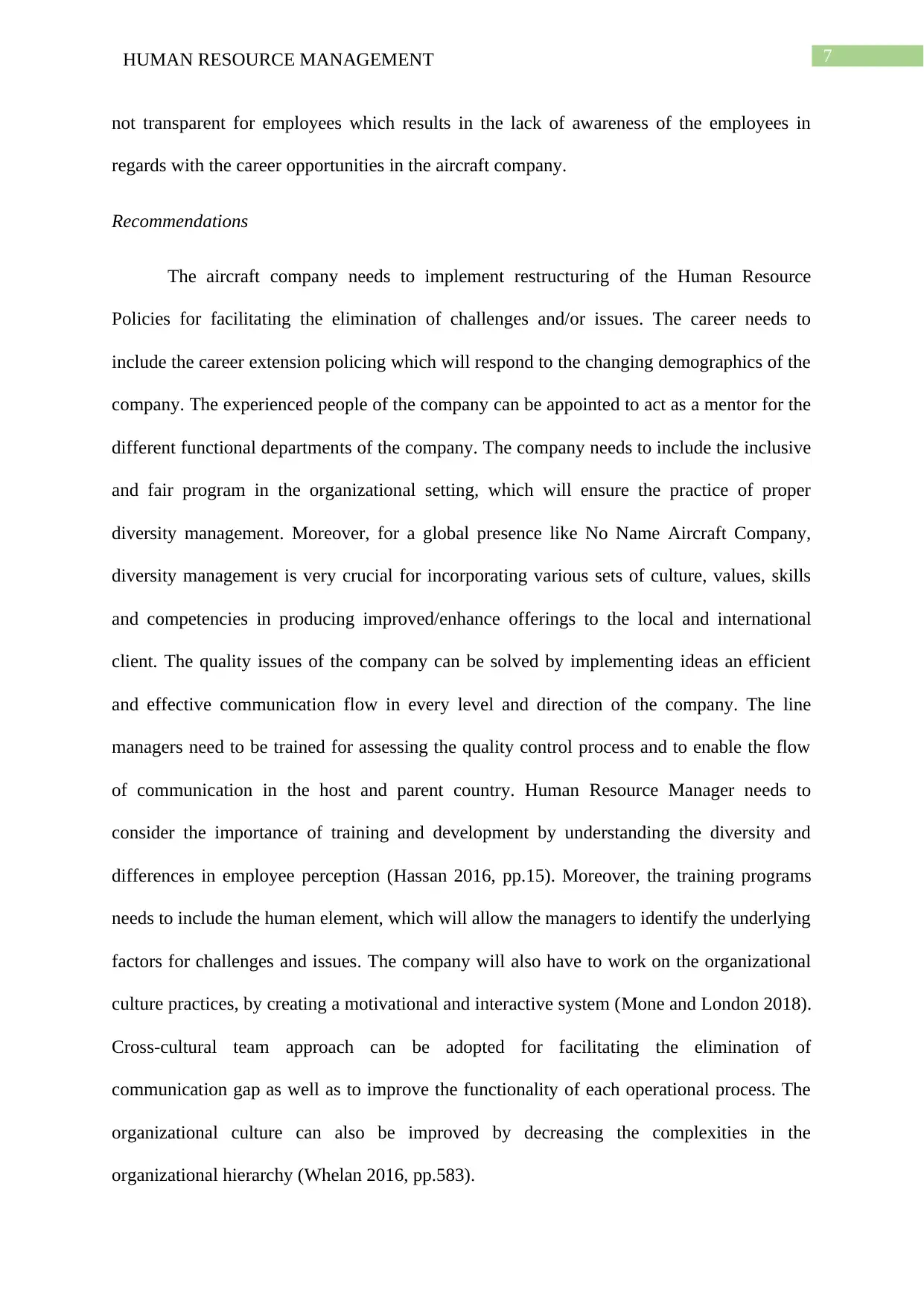
7HUMAN RESOURCE MANAGEMENT
not transparent for employees which results in the lack of awareness of the employees in
regards with the career opportunities in the aircraft company.
Recommendations
The aircraft company needs to implement restructuring of the Human Resource
Policies for facilitating the elimination of challenges and/or issues. The career needs to
include the career extension policing which will respond to the changing demographics of the
company. The experienced people of the company can be appointed to act as a mentor for the
different functional departments of the company. The company needs to include the inclusive
and fair program in the organizational setting, which will ensure the practice of proper
diversity management. Moreover, for a global presence like No Name Aircraft Company,
diversity management is very crucial for incorporating various sets of culture, values, skills
and competencies in producing improved/enhance offerings to the local and international
client. The quality issues of the company can be solved by implementing ideas an efficient
and effective communication flow in every level and direction of the company. The line
managers need to be trained for assessing the quality control process and to enable the flow
of communication in the host and parent country. Human Resource Manager needs to
consider the importance of training and development by understanding the diversity and
differences in employee perception (Hassan 2016, pp.15). Moreover, the training programs
needs to include the human element, which will allow the managers to identify the underlying
factors for challenges and issues. The company will also have to work on the organizational
culture practices, by creating a motivational and interactive system (Mone and London 2018).
Cross-cultural team approach can be adopted for facilitating the elimination of
communication gap as well as to improve the functionality of each operational process. The
organizational culture can also be improved by decreasing the complexities in the
organizational hierarchy (Whelan 2016, pp.583).
not transparent for employees which results in the lack of awareness of the employees in
regards with the career opportunities in the aircraft company.
Recommendations
The aircraft company needs to implement restructuring of the Human Resource
Policies for facilitating the elimination of challenges and/or issues. The career needs to
include the career extension policing which will respond to the changing demographics of the
company. The experienced people of the company can be appointed to act as a mentor for the
different functional departments of the company. The company needs to include the inclusive
and fair program in the organizational setting, which will ensure the practice of proper
diversity management. Moreover, for a global presence like No Name Aircraft Company,
diversity management is very crucial for incorporating various sets of culture, values, skills
and competencies in producing improved/enhance offerings to the local and international
client. The quality issues of the company can be solved by implementing ideas an efficient
and effective communication flow in every level and direction of the company. The line
managers need to be trained for assessing the quality control process and to enable the flow
of communication in the host and parent country. Human Resource Manager needs to
consider the importance of training and development by understanding the diversity and
differences in employee perception (Hassan 2016, pp.15). Moreover, the training programs
needs to include the human element, which will allow the managers to identify the underlying
factors for challenges and issues. The company will also have to work on the organizational
culture practices, by creating a motivational and interactive system (Mone and London 2018).
Cross-cultural team approach can be adopted for facilitating the elimination of
communication gap as well as to improve the functionality of each operational process. The
organizational culture can also be improved by decreasing the complexities in the
organizational hierarchy (Whelan 2016, pp.583).
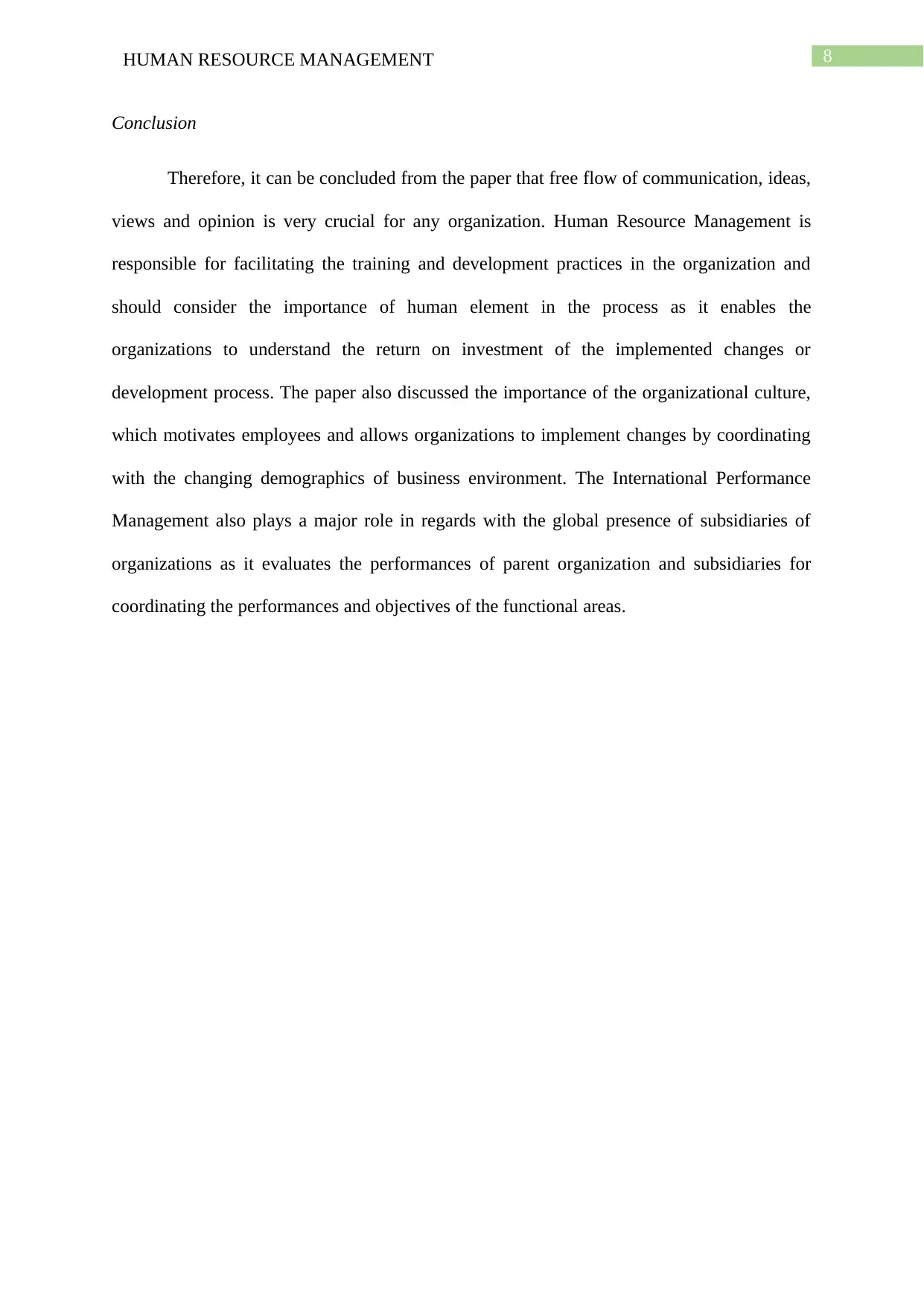
8HUMAN RESOURCE MANAGEMENT
Conclusion
Therefore, it can be concluded from the paper that free flow of communication, ideas,
views and opinion is very crucial for any organization. Human Resource Management is
responsible for facilitating the training and development practices in the organization and
should consider the importance of human element in the process as it enables the
organizations to understand the return on investment of the implemented changes or
development process. The paper also discussed the importance of the organizational culture,
which motivates employees and allows organizations to implement changes by coordinating
with the changing demographics of business environment. The International Performance
Management also plays a major role in regards with the global presence of subsidiaries of
organizations as it evaluates the performances of parent organization and subsidiaries for
coordinating the performances and objectives of the functional areas.
Conclusion
Therefore, it can be concluded from the paper that free flow of communication, ideas,
views and opinion is very crucial for any organization. Human Resource Management is
responsible for facilitating the training and development practices in the organization and
should consider the importance of human element in the process as it enables the
organizations to understand the return on investment of the implemented changes or
development process. The paper also discussed the importance of the organizational culture,
which motivates employees and allows organizations to implement changes by coordinating
with the changing demographics of business environment. The International Performance
Management also plays a major role in regards with the global presence of subsidiaries of
organizations as it evaluates the performances of parent organization and subsidiaries for
coordinating the performances and objectives of the functional areas.
⊘ This is a preview!⊘
Do you want full access?
Subscribe today to unlock all pages.

Trusted by 1+ million students worldwide
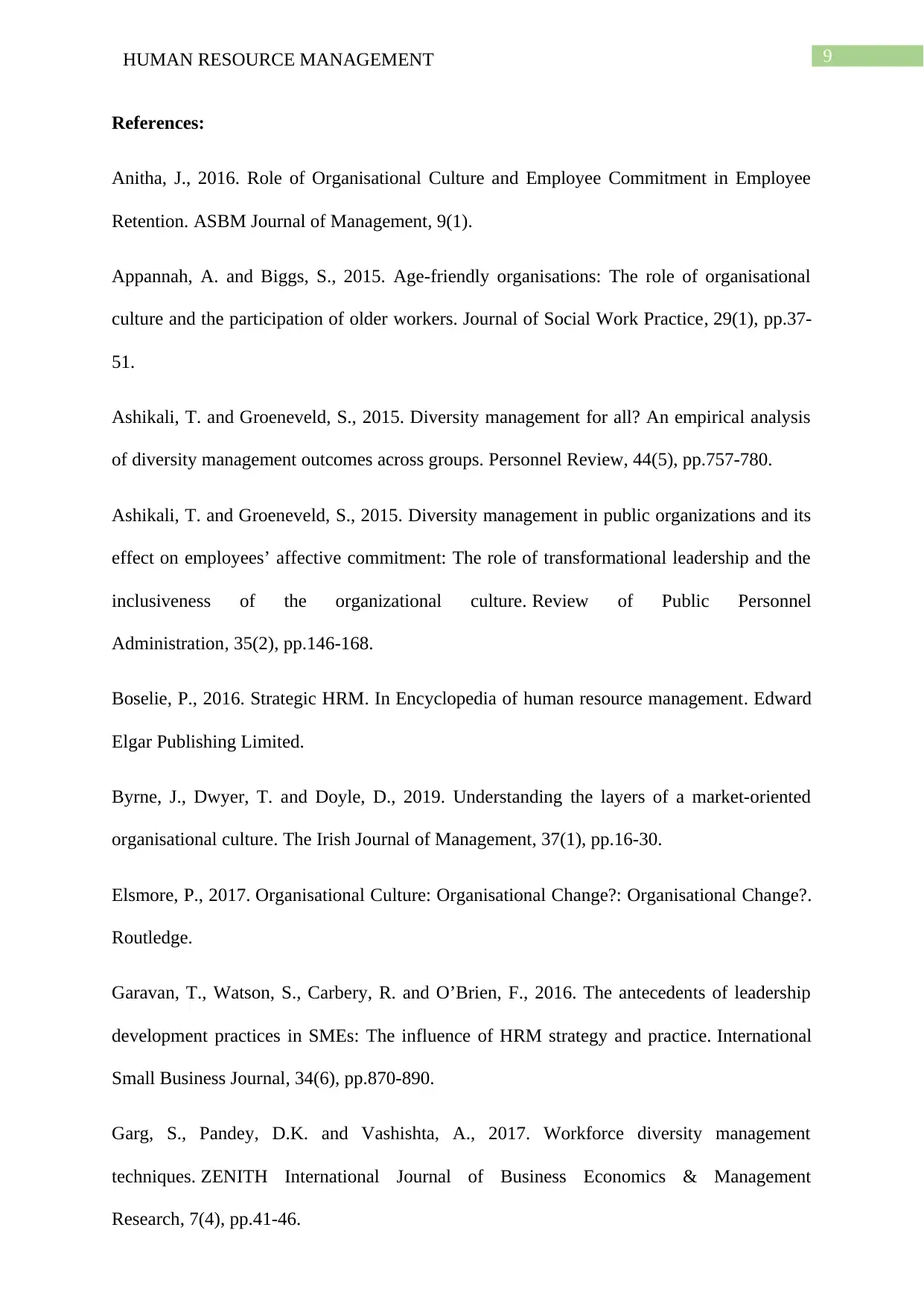
9HUMAN RESOURCE MANAGEMENT
References:
Anitha, J., 2016. Role of Organisational Culture and Employee Commitment in Employee
Retention. ASBM Journal of Management, 9(1).
Appannah, A. and Biggs, S., 2015. Age-friendly organisations: The role of organisational
culture and the participation of older workers. Journal of Social Work Practice, 29(1), pp.37-
51.
Ashikali, T. and Groeneveld, S., 2015. Diversity management for all? An empirical analysis
of diversity management outcomes across groups. Personnel Review, 44(5), pp.757-780.
Ashikali, T. and Groeneveld, S., 2015. Diversity management in public organizations and its
effect on employees’ affective commitment: The role of transformational leadership and the
inclusiveness of the organizational culture. Review of Public Personnel
Administration, 35(2), pp.146-168.
Boselie, P., 2016. Strategic HRM. In Encyclopedia of human resource management. Edward
Elgar Publishing Limited.
Byrne, J., Dwyer, T. and Doyle, D., 2019. Understanding the layers of a market-oriented
organisational culture. The Irish Journal of Management, 37(1), pp.16-30.
Elsmore, P., 2017. Organisational Culture: Organisational Change?: Organisational Change?.
Routledge.
Garavan, T., Watson, S., Carbery, R. and O’Brien, F., 2016. The antecedents of leadership
development practices in SMEs: The influence of HRM strategy and practice. International
Small Business Journal, 34(6), pp.870-890.
Garg, S., Pandey, D.K. and Vashishta, A., 2017. Workforce diversity management
techniques. ZENITH International Journal of Business Economics & Management
Research, 7(4), pp.41-46.
References:
Anitha, J., 2016. Role of Organisational Culture and Employee Commitment in Employee
Retention. ASBM Journal of Management, 9(1).
Appannah, A. and Biggs, S., 2015. Age-friendly organisations: The role of organisational
culture and the participation of older workers. Journal of Social Work Practice, 29(1), pp.37-
51.
Ashikali, T. and Groeneveld, S., 2015. Diversity management for all? An empirical analysis
of diversity management outcomes across groups. Personnel Review, 44(5), pp.757-780.
Ashikali, T. and Groeneveld, S., 2015. Diversity management in public organizations and its
effect on employees’ affective commitment: The role of transformational leadership and the
inclusiveness of the organizational culture. Review of Public Personnel
Administration, 35(2), pp.146-168.
Boselie, P., 2016. Strategic HRM. In Encyclopedia of human resource management. Edward
Elgar Publishing Limited.
Byrne, J., Dwyer, T. and Doyle, D., 2019. Understanding the layers of a market-oriented
organisational culture. The Irish Journal of Management, 37(1), pp.16-30.
Elsmore, P., 2017. Organisational Culture: Organisational Change?: Organisational Change?.
Routledge.
Garavan, T., Watson, S., Carbery, R. and O’Brien, F., 2016. The antecedents of leadership
development practices in SMEs: The influence of HRM strategy and practice. International
Small Business Journal, 34(6), pp.870-890.
Garg, S., Pandey, D.K. and Vashishta, A., 2017. Workforce diversity management
techniques. ZENITH International Journal of Business Economics & Management
Research, 7(4), pp.41-46.
Paraphrase This Document
Need a fresh take? Get an instant paraphrase of this document with our AI Paraphraser
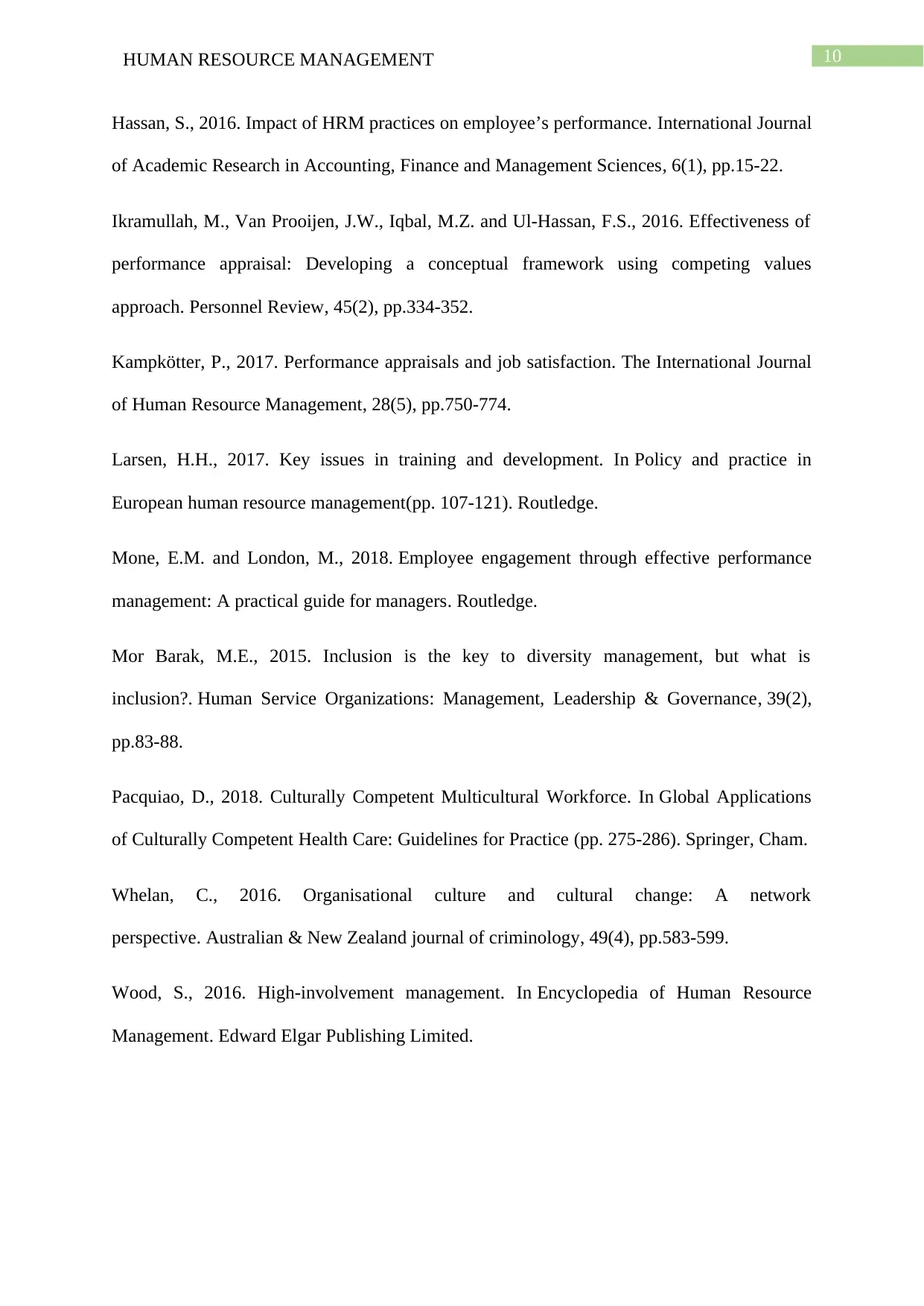
10HUMAN RESOURCE MANAGEMENT
Hassan, S., 2016. Impact of HRM practices on employee’s performance. International Journal
of Academic Research in Accounting, Finance and Management Sciences, 6(1), pp.15-22.
Ikramullah, M., Van Prooijen, J.W., Iqbal, M.Z. and Ul-Hassan, F.S., 2016. Effectiveness of
performance appraisal: Developing a conceptual framework using competing values
approach. Personnel Review, 45(2), pp.334-352.
Kampkötter, P., 2017. Performance appraisals and job satisfaction. The International Journal
of Human Resource Management, 28(5), pp.750-774.
Larsen, H.H., 2017. Key issues in training and development. In Policy and practice in
European human resource management(pp. 107-121). Routledge.
Mone, E.M. and London, M., 2018. Employee engagement through effective performance
management: A practical guide for managers. Routledge.
Mor Barak, M.E., 2015. Inclusion is the key to diversity management, but what is
inclusion?. Human Service Organizations: Management, Leadership & Governance, 39(2),
pp.83-88.
Pacquiao, D., 2018. Culturally Competent Multicultural Workforce. In Global Applications
of Culturally Competent Health Care: Guidelines for Practice (pp. 275-286). Springer, Cham.
Whelan, C., 2016. Organisational culture and cultural change: A network
perspective. Australian & New Zealand journal of criminology, 49(4), pp.583-599.
Wood, S., 2016. High-involvement management. In Encyclopedia of Human Resource
Management. Edward Elgar Publishing Limited.
Hassan, S., 2016. Impact of HRM practices on employee’s performance. International Journal
of Academic Research in Accounting, Finance and Management Sciences, 6(1), pp.15-22.
Ikramullah, M., Van Prooijen, J.W., Iqbal, M.Z. and Ul-Hassan, F.S., 2016. Effectiveness of
performance appraisal: Developing a conceptual framework using competing values
approach. Personnel Review, 45(2), pp.334-352.
Kampkötter, P., 2017. Performance appraisals and job satisfaction. The International Journal
of Human Resource Management, 28(5), pp.750-774.
Larsen, H.H., 2017. Key issues in training and development. In Policy and practice in
European human resource management(pp. 107-121). Routledge.
Mone, E.M. and London, M., 2018. Employee engagement through effective performance
management: A practical guide for managers. Routledge.
Mor Barak, M.E., 2015. Inclusion is the key to diversity management, but what is
inclusion?. Human Service Organizations: Management, Leadership & Governance, 39(2),
pp.83-88.
Pacquiao, D., 2018. Culturally Competent Multicultural Workforce. In Global Applications
of Culturally Competent Health Care: Guidelines for Practice (pp. 275-286). Springer, Cham.
Whelan, C., 2016. Organisational culture and cultural change: A network
perspective. Australian & New Zealand journal of criminology, 49(4), pp.583-599.
Wood, S., 2016. High-involvement management. In Encyclopedia of Human Resource
Management. Edward Elgar Publishing Limited.
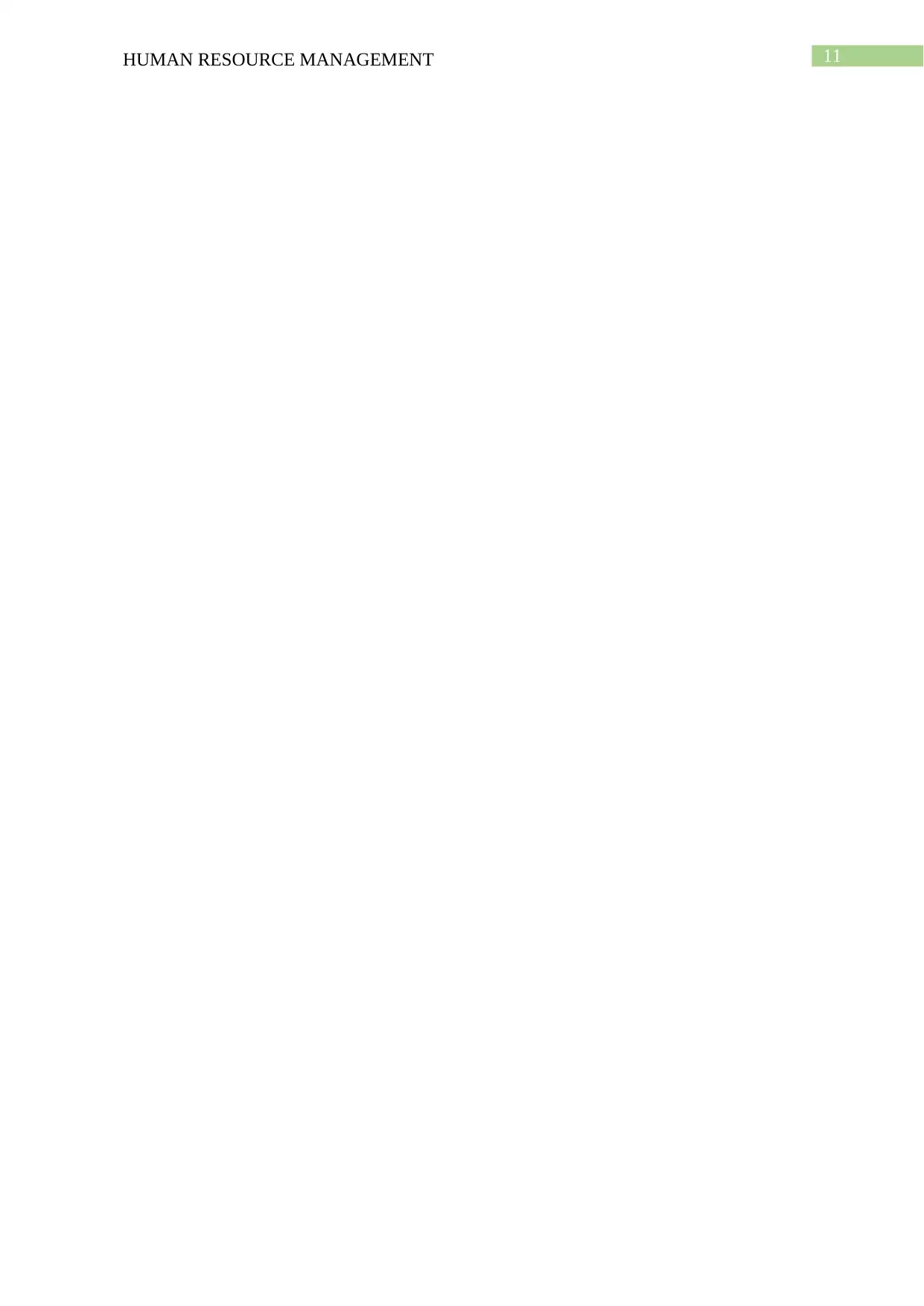
11HUMAN RESOURCE MANAGEMENT
⊘ This is a preview!⊘
Do you want full access?
Subscribe today to unlock all pages.

Trusted by 1+ million students worldwide
1 out of 12
Related Documents
Your All-in-One AI-Powered Toolkit for Academic Success.
+13062052269
info@desklib.com
Available 24*7 on WhatsApp / Email
![[object Object]](/_next/static/media/star-bottom.7253800d.svg)
Unlock your academic potential
Copyright © 2020–2025 A2Z Services. All Rights Reserved. Developed and managed by ZUCOL.



